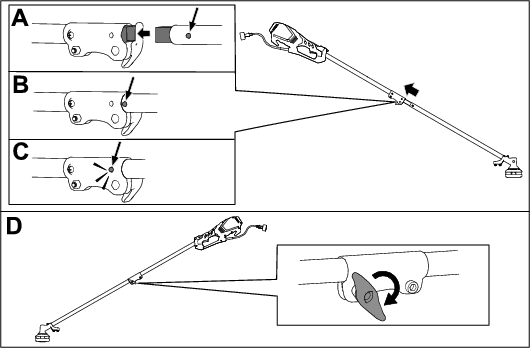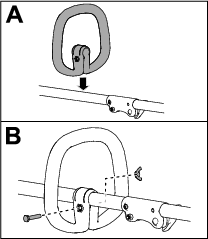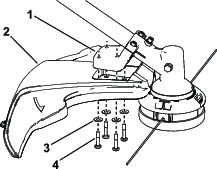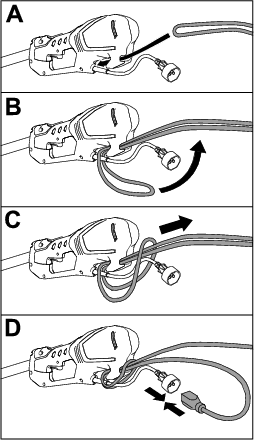WARNING: When using electric gardening appliances, basic safety
precautions should always be followed to reduce the risk of fire,
electric shock, and personal injury, including the following:
Read All Instructions
The term “appliance” in all of the warnings
refers to your mains-operated (corded) appliance or battery-operated
(cordless) appliance.
-
Work area safety
-
Keep work area clean and well lit.Cluttered or dark areas invite accidents.
-
Do not operate appliances in explosive atmospheres,
such as in the presence of flammable liquids, gases, or dust.Appliances create sparks, which may ignite the dust or
fumes.
-
Keep children and bystanders away while
operating an appliance.Distractions can cause
you to lose control.
-
Electrical safety
-
Appliance plugs must match the outlet. Never
modify the plug in any way. Do not use any adapter plugs with earthed
(grounded) appliances.. Unmodified plugs and
matching outlets will reduce risk of electric shock.
-
Avoid body contact with earthed or grounded
surfaces.There is an increased risk of electric
shock if your body is earthed or grounded.
-
Do not abuse the cord. Never use the cord
for carrying, pulling, or unplugging the appliance. Keep cord away
from heat, oil, sharp edges, or moving parts. Damaged or entangled cords increase the risk of electric shock.
-
Do not expose appliances to rain or wet
conditions.Water entering an appliance will
increase the risk of electric shock.
-
When operating an appliance outdoors, use
an extension cord suitable for outdoor use.Use of a cord suitable for outdoor use reduces the risk of electric
shock.
-
Disconnect the plug from the power source
when the appliance is not in use.
-
Personal safety
-
Stay alert; watch what you are doing, and
use common sense when operating an appliance. Do not use an appliance
while you are tired or under the influence of drugs, alcohol, or medication.A moment of inattention while operating appliances may
result in serious personal injury.
-
Use personal protective equipment. Always
wear eye protection. Wear appropriate clothing,
including eye protection; long pants; substantial, slip-resistant
footwear; rubber gloves; and hearing protection. Wear a dust mask
in dusty operating conditions.
-
Dress properly. Tie back long hair and do
not wear loose clothing or jewelry. Keep your hair, clothing and gloves
away from moving parts.Loose clothes, jewelry,
or long hair can be caught in moving parts.
-
Prevent unintentional starting. Ensure the
switch is in the off-position before connecting to power source and/or
battery pack, picking up or carrying the appliance.Carrying appliances with your finger on the switch or energizing
appliances that have the switch on invites accidents.
-
Do not overreach. Keep proper footing and
balance at all times.This enables better control
of the appliance in unexpected situations.
-
Keep hands and feet away from the cutting
area.
-
Do not allow children or untrained people
to operate or service this device. Allow only people who are responsible,
trained, familiar with the instructions, and physically capable to
operate or service the device.
-
Appliance use and care
-
Do not force the appliance. Use the correct
appliance for your application.The correct
appliance will do the job better and safer at the rate for which it
was designed.
-
Do not use the appliance if the switch does
not turn it on and off.Any appliance that cannot
be controlled with the switch is dangerous and must be repaired.
-
Disconnect the plug from the power source
and/or the battery pack from the appliance before making any adjustments,
changing accessories, or storing appliances.Such preventive safety measures reduce the risk of starting the appliance
accidentally.
-
Store idle appliances out of the reach of
children, and do not allow persons unfamiliar with the appliance or
these instructions to operate the appliance.Appliances are dangerous in the hands of untrained users.
-
Store idle appliances indoors.When not in use, appliances should be stored indoors
in a dry and high or locked-up place, out of the reach of children.
-
Maintain appliances. Check for misalignment
or binding of moving parts, breakage of parts, and any other condition
that may affect the operation of the appliance. If damaged, have the
appliance repaired before use.Many accidents
are caused by poorly maintained appliances.
-
Keep cutting s sharp and clean.Properly maintained cutting tools with sharp cutting
edges are less likely to bind and are easier to control.
-
Use the appliance in accordance with these
instructions and in the manner intended for the particular type of
appliance, taking into account the working conditions and the work
to be performed.Use of the appliance for operations
different from those intended could result in a hazardous situation.
-
Keep guards in place and in working order.
-
Ground Fault Circuit Interrupter (GFCI) protection
should be provided on the circuit(s) or outlet(s) to be used for the
gardening appliance. Receptacles are available having built-in GFCI
protection and may be used for this measure of safety.
-
To reduce the risk of electric shock, this appliance
has a polarized plug (one blade is wider than the other) and will
require the use of a polarized extension cord. The appliance plug
will fit into a polarized extension cord only one way. If the plug
does not fit, obtain a correct polarized extension cord. A polarized
extension cord will require the use of a polarized wall outlet. This
plug will fit into the polarized wall outlet only one way. If the
plug still does not fit, contact a qualified electrician to install
the proper wall outlet. Do not change the equipment plug, extension
cord receptacle, or extension cord plug in any way.
-
Service
-
Have your appliance serviced by a qualified
repair person using only identical replacement parts.This will ensure that the safety of the appliance is maintained.
-
If the cord is damaged, it must be replaced
by the manufacturer, its authorized service agent or a similarly qualified
in order to avoid hazard.
-
Double-insulated Appliance
In a double-insulated appliance, 2 systems of insulation are
provided instead of grounding. No grounding means is provided on a
double-insulated appliance, nor should a means for grounding be added
to the appliance. Servicing a double-insulated appliance requires
extreme care and knowledge of the system, and should be done only
by the qualified service personnel at your Authorized Service Dealer.
Replacement parts for a double-insulated appliance must be identical
to the parts that they replace. A double-insulated appliance is marked
with the words “Double Insulation” or “Double Insulated.”
The symbol ( ) may also be marked on the appliance.
) may also be marked on the appliance.
-
Extension Cord
Warning
Using an incorrect extension cord may result in electric shock.
Use only with an extension cord intended for outdoor use, such
as an extension cord of cord type SW-A, SOW-A, STW-A, STOW-A, SJW-A,
SJOW-A, SJTW-A, or SJTOW-A
Use only three-wire extension cords that have three-prong grounding
plugs and grounding receptacles that accept the appliance’s
plug.
Ensure that your extension cord is in good condition. When using
an extension cord, use one heavy enough to carry the current your
product will draw. An undersized extension cord will cause a drop
in line voltage, resulting in loss of power and overheating. The following
table lists the correct cord size depending on the length of the cord.
If you are in doubt, use the next heavier gauge. The smaller the gauge
number, the heavier the cord.
| Extension Cord Length | Minimum Wire Gauge (A.W.G.) |
| 7.6 m (25 feet) | 16 |
| 15.0 m (50 feet) | 16 |
| 30.5 m (100 feet) | 16 |
| 45.7 m (150 feet) | 14 |
Note: Do not use an extension cord over 45.7 m (150 feet) long.
To reduce the risk of disconnection of the extension cord during
use, connect the extension cord to the trimmer as illustrated in Connecting to a Power Source.
Do not allow children or untrained people to operate or service
this device. Allow only people who are responsible, trained, familiar
with the instructions, and physically capable to operate or service
the device.
SAVE THESE INSTRUCTIONS
Electrical specifications: 120V ~ 60Hz 5A
Safety and Instructional Decals
 |
Safety decals and instructions are easily visible to
the operator and are located near any area of potential danger. Replace
any decal that is damaged or missing.
|
| Symbol | Name | Explanation |
| AC | Alternating current | Type of current |
| AMPS or A | Amperes | Current |
| Hz | Hertz | Frequency (cycles per second) |
| RPM | Revolutions per minute | Speed of string |
| VOLTS or V | Volts | Voltage |
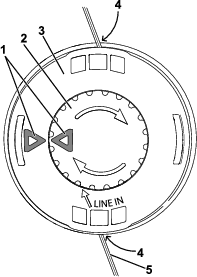

 ) may also be marked on the appliance.
) may also be marked on the appliance.


